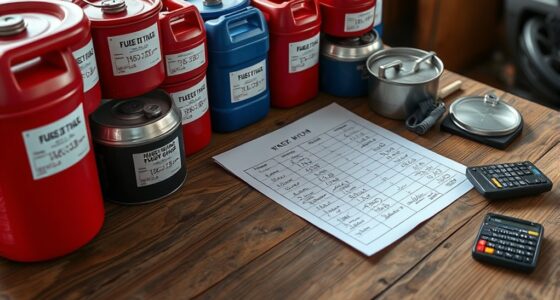When sizing a standby generator, it’s vital to understand the difference between starting and running watts, especially for motor loads like refrigerators or AC units that can require 2-4 times their normal power at startup. Overlooking these surge demands can lead to overloads or power interruptions. Proper sizing considers future needs, fuel types, and critical loads, ensuring safety and compliance. If you want to get it right, keep going – more insights are ahead.
Key Takeaways
- Accurately calculate both starting and running watts, accounting for motor surge demands to prevent overloads.
- Always include a safety margin (~25%) in sizing to accommodate future load growth and unexpected surges.
- Consider fuel type, availability, and seasonal variations to ensure reliable, long-term power during outages.
- Prioritize critical loads and implement load shedding to maintain essential services without overloading the generator.
- Use professional load analysis over online tools for precise sizing, site-specific needs, and regulatory compliance.
Understanding the Difference Between Starting and Running Watts
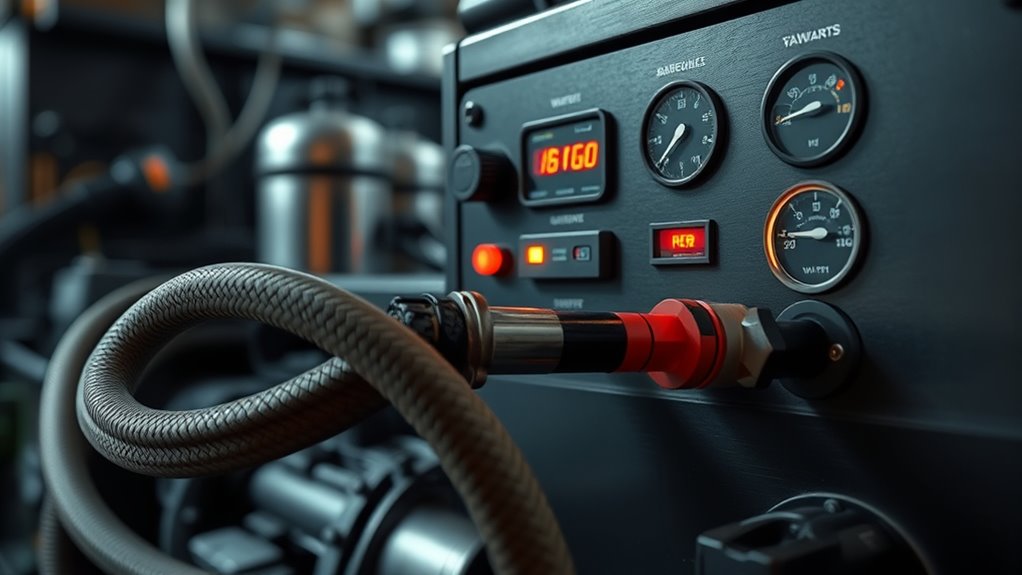
Understanding the difference between starting and running watts is essential for selecting the right generator. Starting watts, also called surge or peak watts, are the extra power needed momentarily to activate appliances with motors or compressors. Running watts, or rated watts, are the continuous power required to keep devices operating after startup. Starting watts last only a few seconds, while running watts sustain the device’s function as long as it’s powered. Motors, compressors, and pumps typically demand higher starting watts than running watts. For example, a refrigerator may need 2-3 times more power to start than to run. When choosing a generator, you must guarantee it can handle both the surge of starting watts and the steady load of running watts to avoid overloads and power interruptions. Additionally, understanding keto diet tracking can help optimize power usage and efficiency for your appliances.
Factors That Influence the Right Generator Size for Your Home
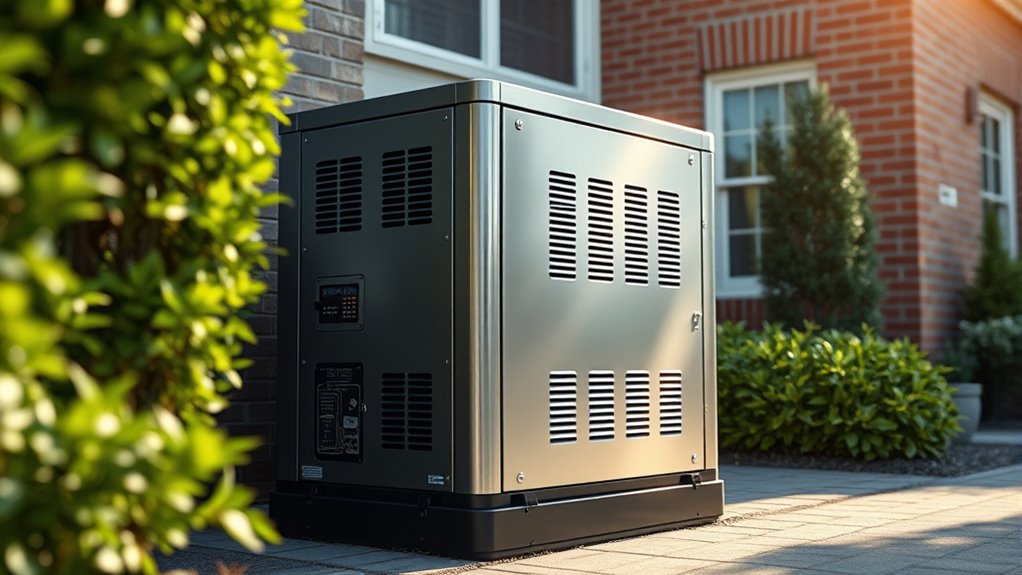
Choosing the right generator size for your home involves considering several key factors that directly impact your power needs. Your home’s size and energy consumption play a significant role; larger homes with more square footage usually require higher-capacity generators due to increased HVAC, lighting, and appliance demands. Homes with all-electric appliances, like water heaters or dryers, tend to need generators at the higher end of capacity. The types and number of appliances, especially high-wattage devices and critical equipment, also influence sizing. Fuel availability and type—natural gas, propane, or diesel—affect operational efficiency and size requirements. Future expansion plans, like adding EV chargers or new systems, should be factored in with a safety margin. Additionally, power demand calculations help ensure the generator can handle peak loads without overtaxing the system. Finally, installation site conditions and environmental factors can impact your generator’s performance and ideal capacity making proper placement and ventilation essential.
The Importance of Professional Load Analysis Before Sizing

You need an accurate load calculation to determine the right generator size and avoid costly mistakes. A professional load analysis also considers future power needs, helping you plan for growth and avoid premature upgrades. Skipping this step can lead to undersized or oversized generators that don’t meet your long-term requirements. Moreover, many load sizing programs are outdated and fail to account for modern non-linear loads and harmonic distortions that can significantly impact generator performance. Incorporating ventilation considerations into the analysis ensures the generator operates efficiently and safely under varying load conditions.
Accurate Load Calculation
Accurate load calculation is vital to selecting the right standby generator size, as it guarantees your system can handle the actual power demands without risking overloads or inefficiencies. You need to account for both running watts and starting (surge) watts, especially for motor-driven devices that may require 3 to 6 times their normal power during startup. Understanding the power factor of your load and generator—typically around 0.8—is fundamental for precise sizing. Using proper formulas to convert amps to watts and identifying loads with motors helps prevent under- or overestimating your needs. Following NEC guidelines and incorporating a safety margin of about 25% ensures your generator can reliably support your essential equipment. Proper load analysis also involves considering load diversity to optimize performance, extend generator lifespan, and keep costs in check. Accurate load calculation optimizes performance, extends generator lifespan, and keeps costs in check. Proper load analysis ensures that all system components are correctly evaluated for optimal sizing and operation.
Future Power Needs
Planning for future power needs is essential to guarantee your backup generator remains reliable as your electrical demands grow. Without proper analysis, you risk undersizing or oversizing, leading to costly failures or unnecessary expenses. A professional load assessment considers current loads and anticipates future increases due to expansion, new equipment, or technological upgrades. It evaluates complex factors like motor startup currents, harmonics, and load diversity. This comprehensive evaluation ensures your generator can handle peak demands during critical times. Use the table below to understand key considerations:
| Factor | Impact |
|---|---|
| Load growth estimates | Prevents undersizing during expansion |
| Motor starting currents | Avoids outages caused by transient high demands |
| Seasonal variations | Ensures capacity during peak periods |
| Equipment additions | Supports seamless capacity upgrades |
| Proper load analysis ensures your generator is correctly sized for both current and future needs.
How to Prioritize Critical Loads for Efficient Backup Power
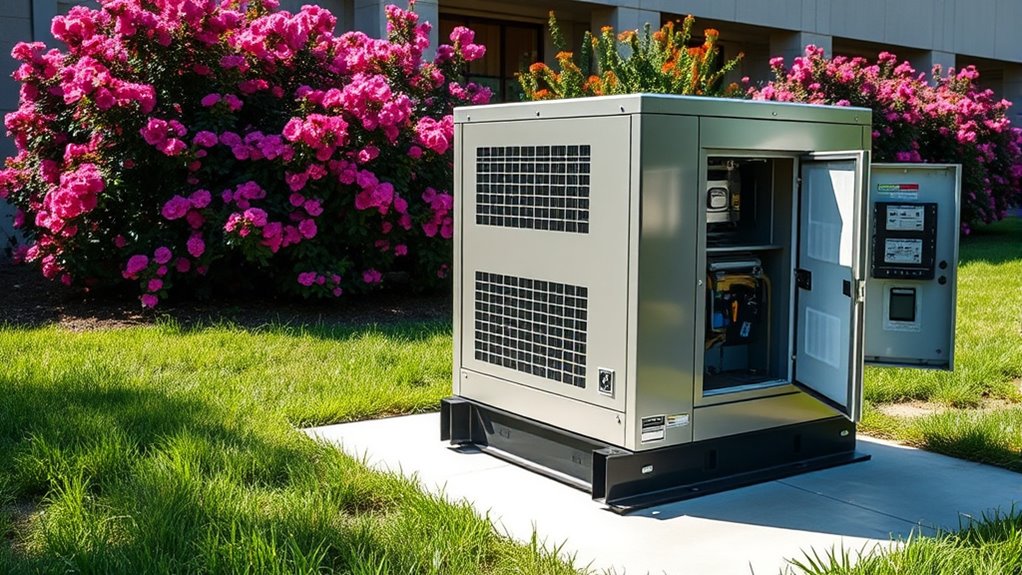
Prioritizing essential loads is crucial to guarantee your backup power system remains reliable during outages. Start by identifying essential devices like medical equipment, refrigeration, security systems, and communication tools. Categorize these loads into vital (must stay on), important (if capacity allows), and nonessential (shed during shortages). Calculate each device’s wattage to determine total critical load, considering both continuous and intermittent demands. Incorporate future expansion needs and leave a margin for added equipment. Use load shedding techniques to disconnect nonessential loads automatically, ensuring essential devices stay powered. Employ load shifting to reschedule non-critical tasks during low-demand periods. Design a critical load panel that isolates vital circuits, optimizing generator capacity, maintaining power stability, and preventing overloads. Proper prioritization guarantees efficient use of backup power when you need it most. Load management techniques can further enhance system efficiency by dynamically adjusting loads based on real-time demand, preventing overloads and conserving fuel. Additionally, understanding generator sizing ensures your system is neither underpowered nor excessively large, leading to cost savings and improved performance.
Common Mistakes to Avoid When Selecting a Generator
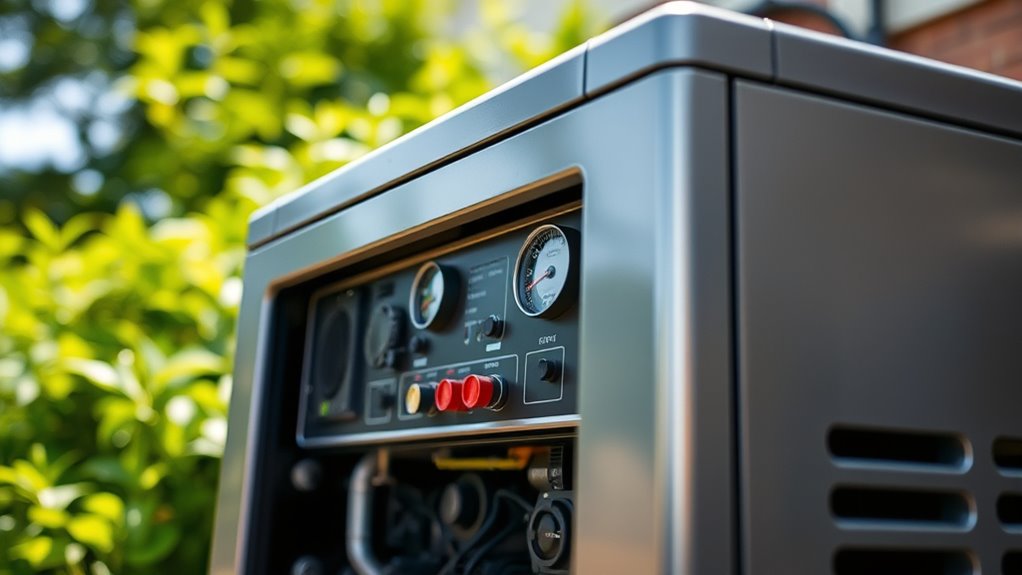
One common mistake is underestimating the starting power your loads require, which can cause equipment to fail during startup. Relying solely on online tools or calculators without proper verification often results in inaccurate sizing. Additionally, ignoring local regulations and code requirements can lead to compliance issues and costly redesigns. Failing to account for generator power factor and load characteristics during the selection process can also result in undersized units that struggle to handle peak loads or sustain voltage stability under varying conditions. It’s crucial to consider fuel efficiency and how it impacts long-term operational costs when choosing a generator.
Underestimating Starting Power
Underestimating the starting power requirements of your appliances is a common mistake that can lead to serious issues with your generator system. Many motor-driven appliances, like refrigerators and air conditioners, need two to four times their running watts during startup. If you only consider running wattage, your generator might not handle these surges, causing overloads or nuisance trips. For example, a refrigerator with 800 running watts may require 1,600 watts to start, and a 4-ton AC unit can need up to 15,000 surge watts. Failing to account for these surges risks power interruptions during outages. To avoid this, always include the highest starting wattage of each appliance in your calculations. Proper sizing ensures your generator can handle startup demands without compromise. Additionally, understanding catering and delivery trends can help you better plan for reliable power needs during busy service times or special events.
Relying on Online Tools
Relying solely on online generator sizing tools can lead to significant errors if you’re not cautious. These tools use different modeling approaches and default assumptions, which can produce inconsistent recommendations for the same project. Some calculate voltage dips over multiple cycles, while others focus on instantaneous dips, affecting size estimates. The accuracy of these tools depends heavily on your input data; defaults often don’t reflect your actual loads. Manufacturer-specific or custom alternators also influence results, yet many calculators ignore these details. Although convenient, online tools can’t replace professional load analysis or site-specific assessments. Over-relying on them may lead to undersized units, causing trips, or oversized systems, increasing costs. Always verify inputs and consider expert evaluation for reliable, safe generator sizing. Additionally, understanding load calculations and how to properly assess your home’s power needs can improve your generator selection process.
Overlooking Local Regulations
Overlooking local regulations when selecting a generator can lead to costly delays, safety hazards, and potential legal issues. Failing to comply with rules like NFPA 110 standards, setback distances, and permit requirements risks fines or removal. Ignoring local fire and noise ordinances may cause unsafe placements or disturbances. You could also face delays if you don’t secure necessary permits beforehand. Additionally, neglecting electrical code requirements and transfer switch standards can compromise safety and system reliability. To avoid these pitfalls, keep in mind:
- Ensure compliance with NFPA 110 safety and installation standards which are enforced by local authorities and require thorough testing and approval.
- Follow setback and clearance rules for fire and ventilation safety.
- Obtain all required permits before installation.
- Meet electrical code and transfer switch regulations.
- Consider local noise and environmental restrictions.
- Staying informed about local regulations and codes helps ensure your generator’s safe, legal, and reliable operation.
The Role of Local Codes and Safety Requirements in Proper Sizing
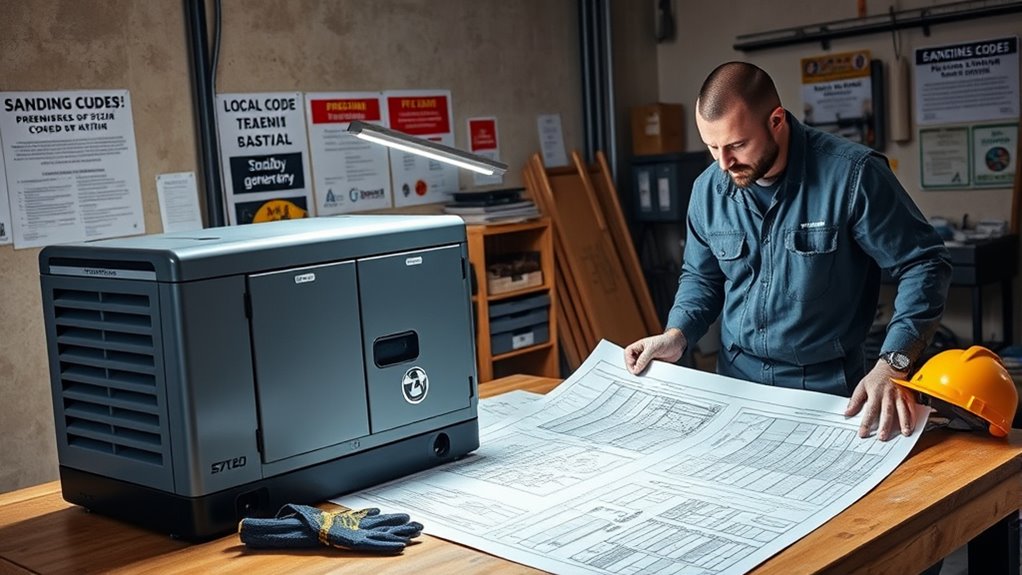
Local codes and safety requirements play a crucial role in making sure your standby generator is properly sized and installed. Compliance with the NEC standards, such as NEC 225, 240, 250, and 445, guarantees safe circuit protection, grounding, and reliable operation. Many jurisdictions require permits to verify placement, anchoring, and safe distances from structures, often mandating setbacks of at least 5 feet to minimize fire hazards. Proper electrical connections, including transfer switches and grounding, are essential for safety and to prevent backfeeding or shocks. Additionally, load calculations must include a 20-30% safety margin, considering both continuous and surge wattages, to accommodate future growth and transient surges. Adhering to these regulations helps prevent costly fines and ensures your system remains compliant during inspections. Meeting these local codes and safety standards ensures your generator operates safely, reliably, and within legal requirements. Proper understanding of local regulations can also streamline the approval process and avoid delays in installation.
Fuel Types and Their Impact on Generator Capacity Planning

Your choice of fuel vital impacts generator capacity planning because each fuel type has different energy content and efficiency. Availability and storage also play essential roles, affecting how long your generator can run during an outage. Understanding these factors helps you select the right size and guarantee reliable power whenever you need it. For example, propane offers longer shelf life and cleaner operation, which can influence your decision based on storage capabilities and environmental considerations. Additionally, considering the energy density of each fuel helps determine the fuel consumption rate and overall runtime of your generator.
Fuel Efficiency Differences
How does the choice of fuel impact the sizing and operation of standby generators? Your fuel type affects efficiency, operating costs, and runtime. Propane is less efficient than diesel or gasoline, meaning you’ll need more fuel for the same power output. Natural gas offers convenience and stability but varies in efficiency depending on engine design. Diesel engines are highly efficient and provide reliable power, ideal for larger systems. Gasoline, while common in portable units, isn’t suited for long-term standby due to storage issues. Plus, fuel efficiency drops at full load, increasing consumption. Fuel efficiency also influences the overall cost-effectiveness and environmental impact of your generator system.
Capacity Variations by Fuel
Choosing the right fuel for your standby generator directly influences its capacity and how you plan your system. Diesel fuel offers the highest energy density, providing greater power output and longer runtime, especially for heavy-duty applications. Propane and natural gas deliver lower peak capacities but excel in cleaner emissions and consistent performance in cold weather. Gasoline generators are limited in capacity, suited for smaller residential needs, with lower fuel efficiency. Multi-fuel options add flexibility but usually match the capacity of their primary fuel source. Understanding fuel density is essential for accurate capacity planning and system design.
Fuel Availability Considerations
Fuel availability plays a crucial role in planning your standby generator system, as different fuel types have unique storage and supply considerations that can impact reliability during outages. You need to contemplate how easily you can access and store each fuel, especially in emergencies. For example:
- Propane requires pressurized tanks, which can pose safety and aesthetic issues for small properties.
- Diesel is bulkier but easier to store in large quantities, ideal for remote sites.
- Gasoline has a short shelf life and needs frequent refills, making it less reliable long-term.
- Natural gas is delivered through pipelines, offering continuous supply if infrastructure exists.
- Some rural areas lack reliable access to natural gas or propane but often have diesel readily available.
- Proper storage and handling of fuel is essential to ensure safe and consistent operation of your generator.
Choosing the right fuel depends on your location, storage capacity, and reliability needs.
Seasonal Variations and Future Load Considerations
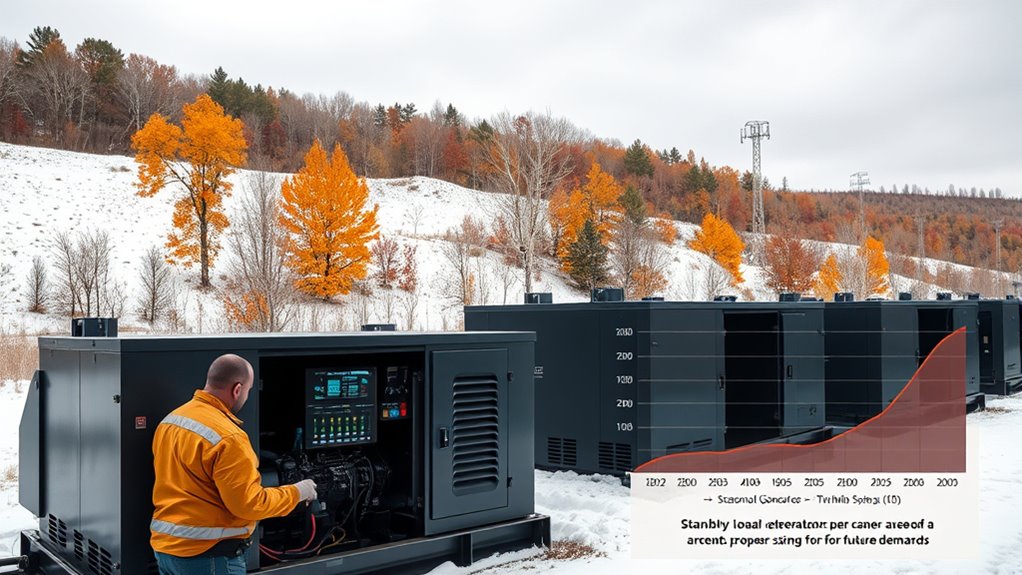
Seasonal variations in weather substantially influence your home’s power needs throughout the year. In winter, heating systems like electric heaters increase demand, while in summer, air conditioning and dehumidifiers push loads higher. Failing to contemplate these fluctuations risks inadequate power during peak seasons. Planning for future load growth—such as adding EV chargers or new appliances—ensures your generator can handle expanded needs. To avoid costly upgrades, size your generator about 25% above current peak demand. Remember, peak demands often exceed continuous loads, especially during startup of motors or surge appliances. Using demand data from utility bills or meters helps identify seasonal peaks accurately. Choosing the right generator type depends on seasonal load profiles, with standby units offering more stable power for year-round reliability. Additionally, understanding seasonal load variations can help you optimize your generator sizing for all weather conditions.
Benefits of Customized Solutions Versus Off-the-Shelf Calculators
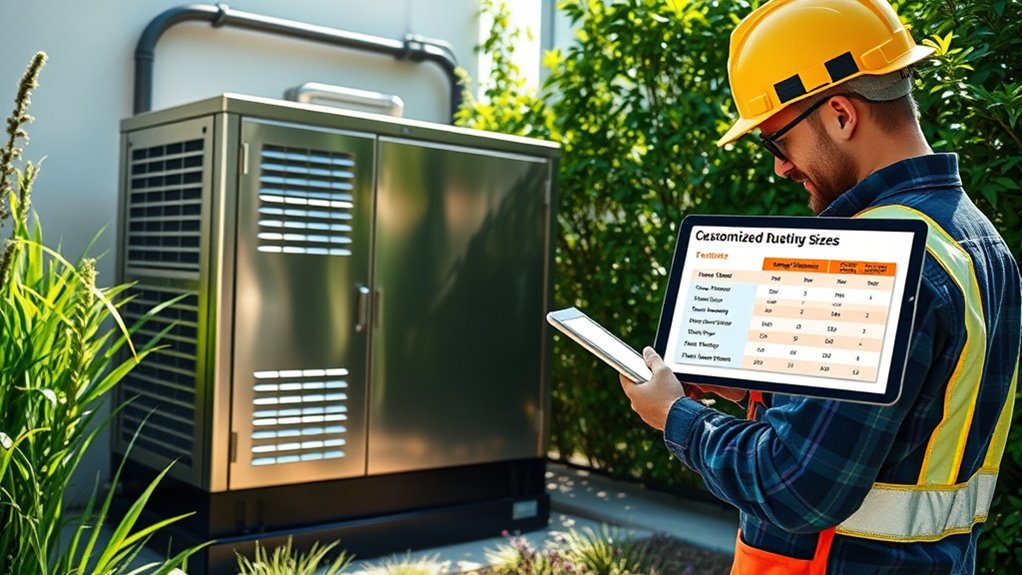
Choosing customized generator solutions guarantees that your power system accurately aligns with your particular load needs, preventing issues caused by under- or oversizing. Off-the-shelf calculators often overlook unique site conditions and specific load profiles, risking inefficient performance or costly upgrades later. Custom solutions tailor capacity, ensuring your appliances and systems operate reliably while extending generator lifespan. They also allow you to select fuel types and enclosures suited to your environment, boosting sustainability and safety. Advanced control and monitoring features enable real-time data, remote management, and smarter load handling. Plus, customization considers physical constraints and weather factors, facilitating seamless integration. Incorporating whole-house system considerations can further enhance the overall efficiency and reliability of your backup power setup.
Ensuring Safe and Legal Installation Practices
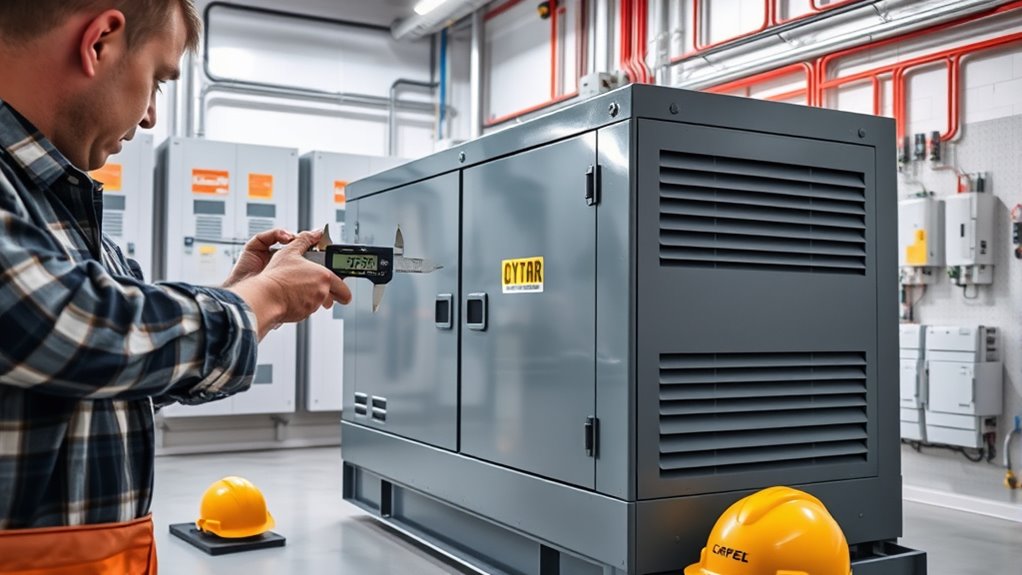
Proper installation of your standby generator is essential to guarantee it operates safely and complies with all legal requirements. You must obtain the necessary permits from federal, state, and local authorities, including emissions certification and periodic renewals. Follow manufacturer guidelines and local building codes during installation, repair, and maintenance to stay compliant. Verify the generator is placed outdoors in a well-ventilated area, at least 5 feet from windows, doors, and vents, on stable, noncombustible surfaces. Maintain clear space around the unit for airflow and direct exhaust away from living spaces. Use a transfer switch to prevent backfeeding, and properly ground the system. Always disconnect power sources before servicing, and install carbon monoxide alarms outdoors and on every level to protect your household. Regular inspection and proper storage can also extend the lifespan of your generator and ensure it operates reliably when needed.
Frequently Asked Questions
How Do I Determine My Home’s Total Essential Load for Generator Sizing?
To determine your home’s essential load, start by listing all critical appliances and systems, noting their running and starting wattages. Add up the continuous wattages and include the highest surge wattage for devices with motors or compressors. Multiply this total by 125% for safety, then round up to the nearest standard generator size. Prioritize safety and reliability, and consider consulting a professional for precise load calculations.
Can Generator Size Affect Fuel Efficiency and Operational Costs Long-Term?
Yes, your generator size considerably impacts long-term fuel efficiency and operational costs. If it’s too large, it’ll run at low loads, wasting fuel and increasing maintenance. Too small, and it’ll operate at full capacity constantly, raising fuel use and wear. Matching the size closely to your load needs keeps fuel consumption ideal, reduces wear, and lowers costs over time, making your backup system more reliable and economical.
What Are the Risks of Oversizing or Undersizing My Standby Generator?
Oversizing your generator wastes money and causes inefficient fuel use, while undersizing risks power failures and equipment damage. You might face mechanical wear from frequent cycling if it’s too large, or overload hazards if it’s too small. Proper sizing balances capacity and demand, ensuring reliable operation without unnecessary costs or safety risks. Careful load assessment and professional installation help you avoid these pitfalls and keep your system running smoothly.
How Often Should I Reevaluate My Generator Capacity as My Home Changes?
You should reevaluate your generator capacity whenever your home’s electrical load changes considerably, like adding new appliances, remodeling, or installing high-power systems. It’s also wise to do a check annually to catch gradual increases in demand. After seasonal shifts or environmental changes, reassess to guarantee your generator can handle current needs. Regular monitoring and maintenance help keep your system properly sized and reliable for your evolving home.
Are There Specific Local Regulations That Limit Generator Size in My Area?
Yes, local regulations can limit your generator size. You should check with your local building department or zoning office because they often have specific rules about maximum generator capacity, placement distances, and noise restrictions. These rules guarantee safety and community standards. Always obtain the necessary permits before installation and verify compliance with local codes to avoid fines or needing to relocate your generator later.
Conclusion
Choosing the right generator is like planting a sturdy tree—you want it to grow strong and reliable without overburdening its roots. By understanding your power needs, avoiding common pitfalls, and consulting professionals, you set the stage for seamless backup power. Think of it as crafting a well-balanced ecosystem where every component plays its part. When you invest wisely now, you’ll weather future storms with confidence and resilience.






